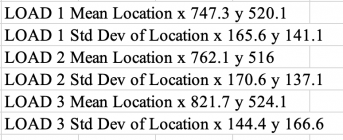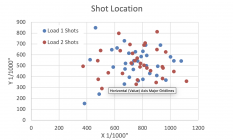I'll blame climate change. It's ruining everything!
Yes... they were 33 rd 'composite' groups. The centers of the individual 3-5 shot groups making up the composite groups did move around a bit - because they were 3-5 rd groups ie very small sample sizes. The individual group sizes and POIs will vary around the mean values in a quantifiable manner.
Yes... they were 33 rd 'composite' groups. The centers of the individual 3-5 shot groups making up the composite groups did move around a bit - because they were 3-5 rd groups ie very small sample sizes. The individual group sizes and POIs will vary around the mean values in a quantifiable manner.
But why with one load, but not the other two? That’s what has me scratching my head.
Some years ago, I had a discussion about this with Steve Hendry. He said that they found that when the barrel is not torqued to 100 ft/lbs these things can happen.
I'll blame climate change. It's ruining everything!
HOW DARE YOU!!



But why with one load, but not the other two? That’s what has me scratching my head.
I haven't gone and downloaded the spreadsheet with the 'raw' data yet... but I'd be surprised if there wasn't some slight movement of the POI even on the others.
Look up the term "standard error of the mean" aka 'SEM' and think about how it might apply to this scenario.
One thing that someone (Miles, from the Hornady podcast) said at some point that really struck a chord for me was (and I'm paraphrasing heavily) that everyone is focused on the sample size of 20, or 30, or whatever. But if you have any background in the most basic statistics... that n=30 sample size is the *floor*, the bare minimum, where it more or less reliably mimics the actual larger population behavior.
That doesn't mean that it's 100% truth, or that the characteristics (size, mean, SD, POI, whatever) won't vary slightly from the true population. We - myself included - tend to see these 'point' statistics and think that's that, there we go, we have a number, done. Reality is... not really.
That starts getting a little bit further down the rabbit hole than most of us want to ever deal with, and most of us are perfectly happy - and shoot perfectly well - with the much more simplistic view of how things work.
It's all good

Caught my attention.
What make torque wrench and model?
How was it ‘calibrated’? By whom?
Really want to know as I have quite a few.
I don’t wonder about the beam type (Stutevant) as I doubt anything happens to them. But that’s foot pounds (lbsft) .
My inch pound ones are not. Is there even an inch pound beam style?
Yes lots of them
Wayne
"Quis Separabit"
Gold $$ Contributor
Thanks for taking the time for your educational reply.
"Quis Separabit"
Gold $$ Contributor
I’m looking for a beam type inch pound torque wrench whose mid range is about scope ring and base numbers. 18-40 inch pounds
Thanks for taking the time for your educational reply.
I’m sorry after I get the mill up and running I’ll take the time to look up a list of options for you. I miss understood your post I guess I just thought you wondered if they made them.
Wayne
"Quis Separabit"
Gold $$ Contributor
I’m sorry after I get the mill up and running I’ll take the time to look up a list of options for you. I miss understood your post I guess I just thought you wondered if they made them.
Wayne
Don’t do it. I can. I’ve always looked after myself just fine
Thanks for taking the time for your educational reply.
Order Presa 3/8 in Drive Beam Style Torque Wrench, 0-80 ft.-lb., PS00600 at Zoro.com. Great prices & free shipping on orders over $50 when you sign in or sign up for an account.

www.zoro.com
Order Presa 3/8 in Drive Beam Style Torque Wrench, 0-80 ft.-lb., PS00600 at Zoro.com. Great prices & free shipping on orders over $50 when you sign in or sign up for an account.

www.zoro.com
A straightforward tool for properly tightening components and fasteners with torque values under 14 Newton meters.

www.parktool.com
I’ll find more later I hope this was more informational than my last post
Wayne
I just read the whole post. Everybody is blaming everything but the shooter. I constantly hear shooters say they are finding their zero. Or, their zero is changing. Or, my zero was off, thats why my group is off. If you ask the top winning shooters, they will tell you their zeros rarely change as the season moves along. Shoot more. Get more consistent in your position and gun handling. Your zeros should firm up.
Yes, but... I'm going to go out on a limb and say Glasscock probably has a pretty good - I'd even say better than average - handle on that sort of thing. Just a guess, tho

But to your point, yes, gun handling can absolutely influence the POI. Back when I (briefly) dabbled in VFS, the local range was configured such that the 200 yd berms were literally 'above' the 100, and the 300 was above *that*. So when you were shooting at the 300 yd target, the rest was up about as far as it would go and the rifle fore end wasn't sitting down flat in the bag, but angled up. As you worked your way around a HBR/VFS target, the poi would shift noticeably. Particularly maddening when going from the sighter bull back to record... Some of the old salts had angled blocks to go under the feet of their rests to 'level' things out.
One of the range day things I do is work on ME to keep my POI from changing
Dry firing is an easy way to determine if your rest/bag setup change is going to show up as a poi shift.
Dry firing is an easy way to determine if your rest/bag setup change is going to show up as a poi shift.
Absolutely!….
Wayne
I downloaded Kieth's data and looked at it in relation to Loads 1 and 2 and whether or not the group locations were moving around on Load 1.
When you look at all 33 shots as a group and calculate the mean point of impact you find that LOAD 1 and Load 2 have almost the same group center and the vertical and horizontal standard deviation is extremely close and not statistically different by the F Test method. The Load 3 mean point of impact is moved horizontally and the distribution is similar to Loads 1 and 2 but now spread more vertically than horizontally. Practically Loads 1 and 2 are the same. Statistically speaking they are the same for this test.

For simplicity let's consider Loads 1 and 2. If you compare the average distance between the group POI and the 33 shot average POI it turns out that Target 1 is 100.1 with a standard deviation of 32.93 and Target 2 is 87.25 with a standard deviation of 27.87 This is based on only 7 values and when compared by Welch's T test (for mean distance) and F Test (for variance) there is no statistical difference in the offsets of the groups.
Anecdotally it appears that the Load 1 groups do appear to move but all nearly within the range of Load 2 groups. We do not have any information that can identify why the group centers move but one possibility is purely sampling and random dispersion. Was it the shooter? If Load 1 and 2 were tested again would the same pattern repeat? The answer is we do not know. What we seem to have is data indicating that Loads 1 and 2 are almost identical in mean POI and in dispersion with less vertical dispersion than Load 3.
This is a situation where 33 shots is not enough to determine if there is a difference between Loads1 and 2 mean radius or average point of impact. It is also not enough data to determine if the point of impacts for the two targets is actually different.







